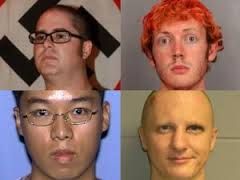Law and Crime
Why Mass Murder and Serial Murder are Not the Same
Mass murder is a catastrophic, one-time event.
Posted February 23, 2015

Mass murder is sometimes confused with serial murder by the public and the media. Such confusion is not surprising. Up until 1974, serial killing was generally referred to as mass murder by criminal justice practitioners and policy makers. Today, however, criminologists, forensic psychologists, criminal justice professionals and legislators recognize that serial murder and mass murder are two very different types of crime with very different motivations and goals on the part of the perpetrator.
Serial Murder
There has been considerable debate among experts over the exact criteria and definition of serial murder. During the past forty years, multiple definitions of serial murder have been used by law enforcement officials, clinicians, academicians and researchers. While these definitions normally share common elements, they differ on specific requirements such as the number of murders required, the types of motivation and the temporal aspects of the murders.
Typically, definitions of serial murder specify a certain number of murders, varying from two to ten victims, as noted by the FBI in an influential 2005 report on serial murder (1). This quantitative requirement distinguishes a serial murder scenario from other categories of murder, especially single homicide, which is by far the most common act of murder in the U.S.
The classic definition of serial murder also requires a period of time between the murders. This pause or break between killings is necessary to distinguish between a mass murder, which is a one-time event, and serial murder, which has multiple incidents. The classic definition of serial murder thus requires a temporal separation between killing incidents which is variably described as a cooling off period or emotional cooling off period.
However, at a major symposium on serial homicide in 2005, the FBI reduced the minimum number of victims from three to two in its definition of serial murder (2). The FBI did this for its own purposes and to satisfy its own institutional needs—that is, to afford itself greater flexibility and breadth in determining when and how to pursue potential serial murder cases. The FBI argued that the older criterion of three or more victims was arbitrary and unnecessary for investigative purposes.
In addition to lowering the minimum number of murder victims in 2005, the FBI also eliminated the cooling off period from its list of required serial homicide criteria. Similar to the rationale it used in lowering the number of victims, the FBI argued that the cooling off period is not a useful requirement for the purposes of criminal investigation.
With all due respect to the FBI, from a social-psychological perspective, I contend that the emotional cooling off period between murders is a key behavioral characteristic that distinguishes the most infamous serial killers such as Jeffrey Dahmer from all other murderers. During the cooling off period between murders, a serial killer disappears from the public eye and resumes his/her seemingly normal routine and life.
Incredibly, the life of a serial killer during the cooling off period, particularly if he/she is a psychopathic killer like Ted Bundy—that is, pathologically devoid of emotion or empathy—may appear completely normal to the unsuspecting observer. As a criminologist, I contend that the cooling off period is very important because it distinguishes the serial killer from all other murderers.
Mass Murder
Mass murder is the act of murdering multiple people, typically simultaneously or over a relatively short period of time. The FBI defined mass murder of this type as killing four or more persons with no cooling-off period between the murders. Stated differently, the FBI defined mass murder as a single incident in which a perpetrator kills four or more people, excluding himself or herself.
As a result of a new federal statute, however, “mass killing” is now officially defined by the government as “three or more” persons killed in a single event (3). Therefore, the federal government has recently reduced the victim requirement from four to three to constitute mass murder in its official definition.
In a mass murder, the victims may be either randomly selected or targeted for a specific reason that only makes sense to the perpetrator. The individual motives for mass murder vary greatly. A common motivation for mass murder is retaliation or revenge, but other motivations are possible, including grandiosity and the need for attention or fame. A mass murder sometimes occurs when the perpetrator, who may be deeply troubled, suffers a psychotic break from reality and strikes out at his/her perceived tormentors in a blitz-like attack.
Unlike serial killers, mass murderers are frequently, but not always, killed at the scene of the crime. Sometimes, they are shot by law enforcement officers called to the crime scene, which is often referred to as “suicide by cop,” while other times mass murderers take their own lives in a final and deliberate act of suicide. From a social-psychological perspective, mass murder is an act of vengeance against society by a desperate and fatalistic individual who has no intention of going away quietly or returning to kill another day.
A classic example of mass murder is the Virginia Tech massacre, a tragic school shooting, which took place on April 16, 2007, on the campus of Virginia Polytechnic Institute in Blacksburg, Virginia. In this mass murder, a very troubled student named Seung-Hui Cho shot and killed thirty-two people and wounded seventeen others in two separate blitz attacks which occurred approximately two hours apart on the Virginia Tech campus. Cho ended his murderous rampage by turning his gun on himself and committing suicide. In addition to the seventeen Cho wounded, another six people were injured while escaping from classroom windows during the attacks. The Virginia Tech massacre is the deadliest shooting incident by a single gunman in U.S. history.
The death toll in the Virginia Tech massacre exceeds that of the deranged James Holmes, who killed twelve people and wounded seventy others in a movie theater in Aurora, Colorado, in July 2012. James Holmes was motivated to commit mass murder by grandiosity and a pathological belief that society did not appreciate his self-perceived genius.
Holmes was hospitalized after attempting suicide several times while in jail in November 2012. After much deliberation, psychiatric evaluation, and the prosecutors’ announcement that they would seek the death penalty, Holmes pleaded not guilty by reason of insanity on June 4, 2013.
In 2014 Judge Carlos Samour ruled that James Holmes had to undergo a second sanity evaluation by the state mental hospital because he concluded that the first was "incomplete and inadequate.” The second evaluation was completed later that same year. Ultimately, his insanity plea was accepted by the court. His trial began on April 27, 2015, and on August 24 he was sentenced to 12 consecutive life sentences plus 3,318 years without parole.
I examine the fantasies and habits of notorious serial killers, including the “Son of Sam” and “Bind, Torture, Kill” based on my personal correspondence with them, in my best-selling book Why We Love Serial Killers: The Curious Appeal of the World’s Most Savage Murderers.
Dr. Scott Bonn is a criminologist, professor, author and TV analyst. Follow him @DocBonn on Twitter and visit his website docbonn.com
References
(1) Morton, R.J. 2005. Serial Murder: Multi-Disciplinary Perspectives for Investigators. National Center for the Analysis of Violent Crime. Washington, D.C.: U.S. Department of Justice. Retrieved http://www.fbi.gov/stats-services/publications/serial-murder
(2) Ibid.
(3) Blair, J. P. and Schweit, K.W. 2014. A Study of Active Shooter Incidents in the United States Between 2000 and 2013. Texas State University and Federal Bureau of Investigation, U.S. Department of Justice, Washington D.C.




